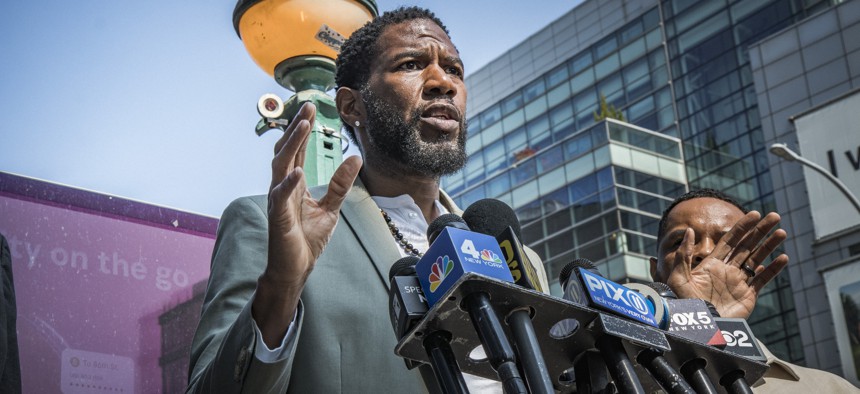Is the Adams administration living under a rock?
They seem to be the only ones in the city who haven’t acknowledged that when it comes to alerting New Yorkers about potential hazards, they’ve repeatedly done too little and too late. It’s time to sound the alarm.
New Yorkers would be forgiven for not knowing about the hazardous conditions that led to flash flooding around the city last Friday until after they woke up, sent their kids to school and went to work. Somehow, they may have missed the 11 p.m. press release from the administration which noted the potential for heavy rain and issued a travel advisory. The administration pointed to this, and to independent weather forecasts, as notice enough of the coming dangers, at least until Mayor Eric Adams’ press conference some 12 hours later. But there is a difference between checking your weather app and hearing directly from city leadership about the potential for dangerous conditions and disruptions.
To their credit, it seems the administration did have some level of planning and measures in place to respond to the flooding once it began. That internal preparedness makes it all the more confusing as to why there was not a more concerted effort to alert the public before the rain began to fall and the streets and subways began to flood. This was most clearly evident in the lack of communication to schools, and subsequently to parents and caregivers, about the potential for flooding, the implementation of a shelter in place or the need to evacuate. Such shortcomings are more than disruptive – they are dangerous.
On the threat of flash flooding, my office has legislation that would require the city Office of Emergency Management to establish a flash flood emergency evacuation plan for residents of multiple dwellings in areas at risk and make residents aware of that plan. Just having these plans, and informing New Yorkers of when they should be employed, would help to protect people and enable them to take informed precautionary measures. But it seems the lack of communication extends beyond flooding and to other emergencies our city faces.
The delays and insufficiencies in notifying the public of potential hazards is becoming a pattern for this administration. This was most recently clear when the skies turned orange with wildfire smoke this summer. There again, the city was late to provide caution or guidance to New Yorkers about the dangers the climate crisis was bringing to our city that day.
In each of these cases, an argument can be made that conditions were ultimately worse than forecasted and that some amount of the hazard or harm was unforeseen. But that does not excuse the failure to prepare New Yorkers, to prime us about the possible harm. Equipped with information, we can choose to take individual precautions and be ready for any system-wide disruptions or dangers. In a best case scenario, conditions will not be as bad as projected, but it's far better to have information and not need it than to need it and not be warned.
Since the onset of the pandemic, my office has pushed to improve the city’s emergency alert systems, including by urging the administration to engage further with local media to broadcast announcements, and connect directly with New Yorkers through more widespread means than Notify NYC. We have also advocated for a clear, tiered system of ranking emergency threats. Under the previous administration, we succeeded in getting such a system for COVID risk. Under this mayor, though, the system was discontinued, even as waves of COVID surges continue to batter our city.
In the face of these deficiencies in communication or preparedness, the administration’s most common response has been to deflect and deny that such errors exist. This was clear in the mayor’s recent response to criticism of his flooding communication strategy and very evident in his hostile response to the City Council hearing on the administration’s actions around the wildfire smoke this summer.
To this administration, critique has been something to dismiss and deflect, rather than an opportunity to improve our city’s governance, and when it comes to emergency response, that strategy is clear and concerning. In addition, there have been disconnects in communication and messaging from senior officials – Schools Chancellor David Banks recently acknowledged errors in communication regarding schools, but elsewhere in the administration, no such reflection is taking place. For an administration that includes the first-ever Deputy Mayor for Communications, messaging is mixed.
In small ways, our questions and suggestions on emergency alerts do seem to have had an impact. Ahead of this week’s possible plume of wildfire smoke and potential decline in air quality, the administration was more forward with the public than it had been about the previous air quality incident over the summer or the flash floods just days earlier. But by initially responding with obstinance, the city wastes valuable time which could be spent improving its approach – and in an emergency, there’s no time to waste.
Climate and public health emergencies are only going to increase in frequency, and in any emergency we are best when we are informed, prepared and united – in advance, not just in response. It’s understandable the administration does not want to ignite panic by declaring that the sky is falling – but when the sky is orange or the streets are flooded, implying there’s nothing to see here is a lot like refusing to look under the rock to see what’s coming.
Jumaane Williams is the New York City Public Advocate.
NEXT STORY: Opinion: It’s time to pay construction workers what they deserve


